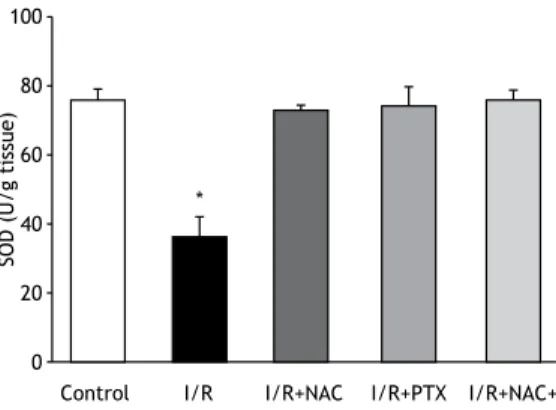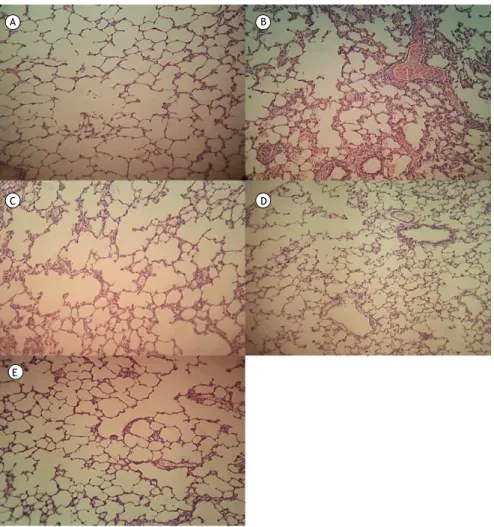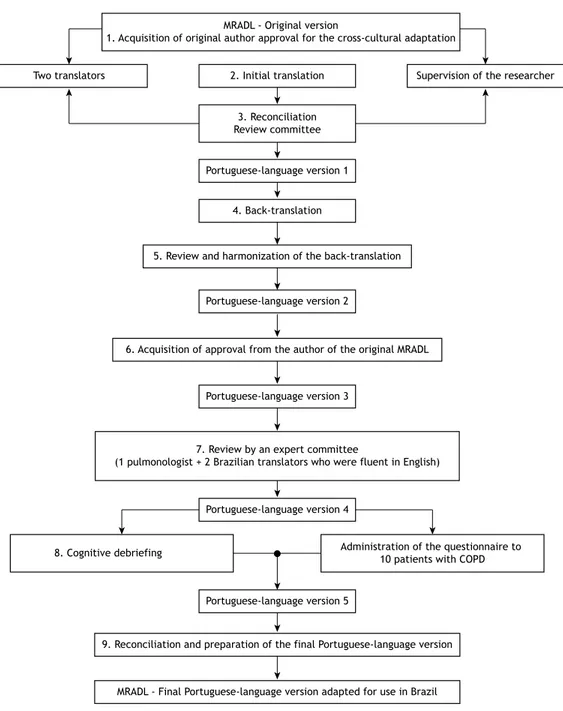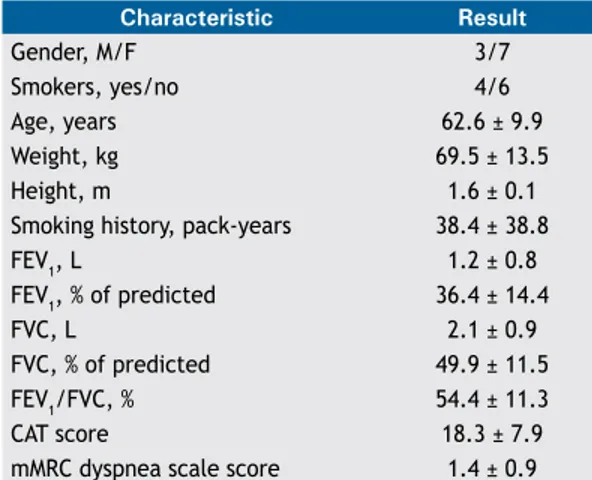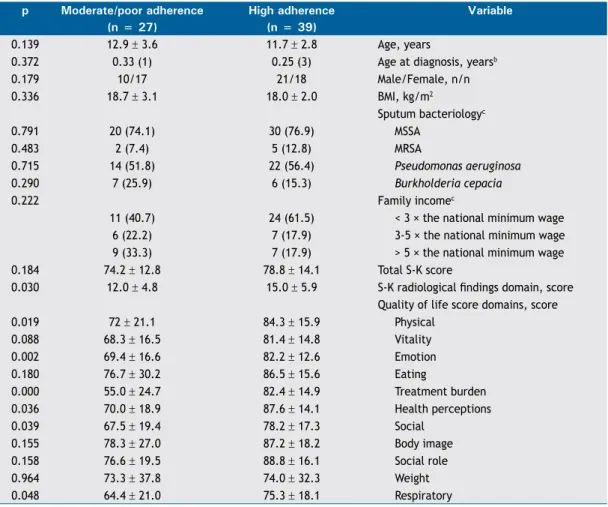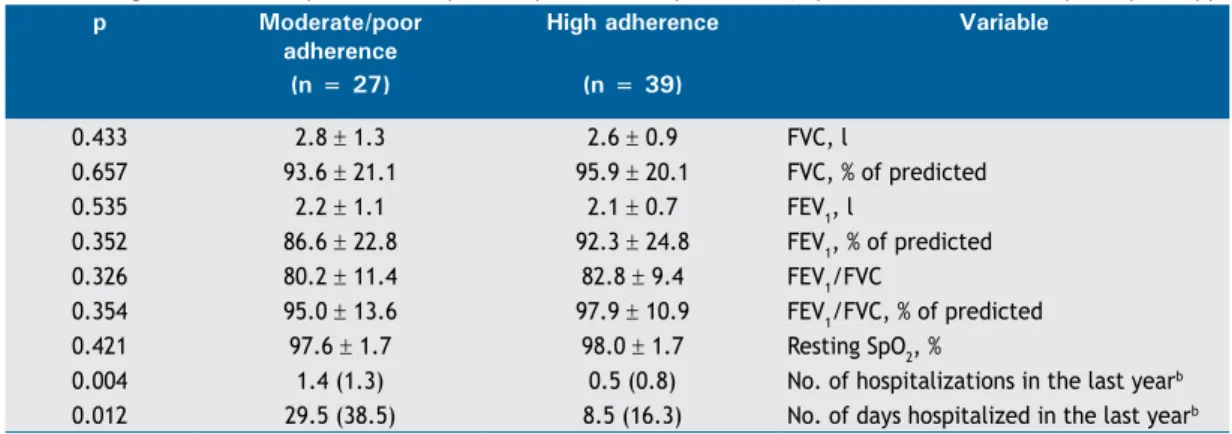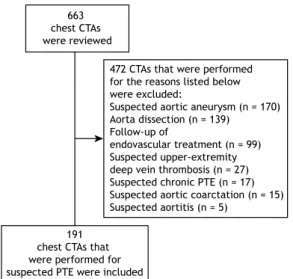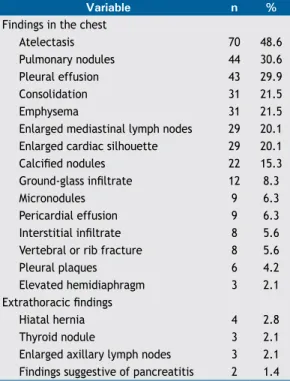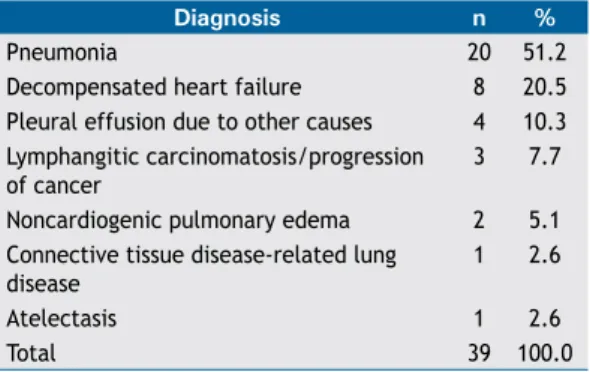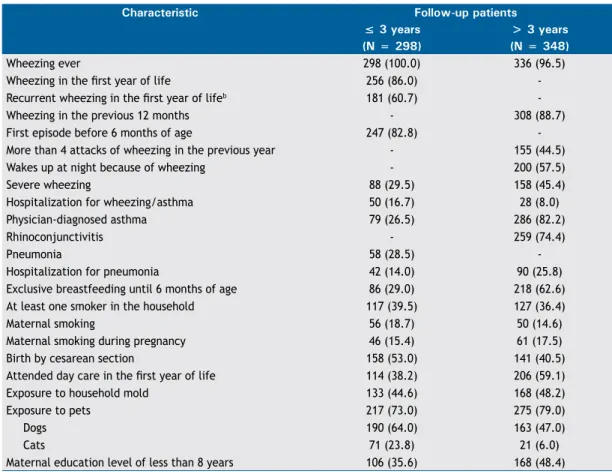ISSN 1806-3713
Published once every two months J Bras Pneumol. v.42, number 1, p. 1-80 January/February 2016
Publicação Indexada em: Latindex, LILACS, Scielo Brazil, Scopus, Index Copernicus, ISI Web of Knowledge, MEDLINE e PubMed Central (PMC)
Disponível eletronicamente nas versões português e inglês: www.jornaldepneumologia.com.br e www.scielo.br/jbpneu
Associação Brasileira de Editores Científicos
I N T E R N A T I O N A L
EDITOR-IN-CHIEF
Rogerio Souza - University of São Paulo, São Paulo, Brazil
EXECUTIVE EDITORS
Bruno Guedes Baldi - University of São Paulo, São Paulo, Brazil
Caio Júlio Cesar dos Santos Fernandes - University of São Paulo, São Paulo, Brazil Carlos Roberto Ribeiro de Carvalho - University of São Paulo, São Paulo, Brazil Carlos Viana Poyares Jardim - University of São Paulo, São Paulo, Brazil
ASSOCIATE EDITORS
Afrânio Lineu Kritski - Federal University of Rio de Janeiro, Brazil Álvaro A. Cruz - Federal University of Bahia, Salvador, Brazil
Celso Ricardo Fernandes de Carvalho - University of São Paulo, São Paulo, Brazil Fábio Biscegli Jatene - University of São Paulo, São Paulo, Brazil
Geraldo Lorenzi-Filho - University of São Paulo, São Paulo, Brazil Ilma Aparecida Paschoal - State University at Campinas, Campinas, Brazil José Alberto Neder- Federal University of São Paulo, São Paulo, Brazil José Antônio Baddini Martinez - University of São Paulo, Ribeirão Preto, Brazil.
Renato Tetelbom Stein - Pontiical Catholic University of Rio Grande do Sul, Porto Alegre, Brazil Sérgio Saldanha Menna Barreto - Federal University of Rio Grande do Sul, Porto Alegre, Brazil
EDITORIAL COUNCIL
Alberto Cukier - University of São Paulo, São Paulo, Brazil
Ana C. Krieger - New York University School of Medicine, New York, NY, USA Ana Luiza de Godoy Fernandes - Federal University of São Paulo, São Paulo, Brazil Antonio Segorbe Luis - University of Coimbra, Coimbra, Portugal
Brent Winston - Department of Critical Care Medicine, University of Calgary, Calgary, Canada Carlos Alberto de Assis Viegas - University of Brasília, Brasília, Brazil
Carlos M. Luna - Hospital de Clinicas, University of Buenos Aires, Buenos Aires, Argentina Carmem Silvia Valente Barbas - University of São Paulo, São Paulo, Brazil
Chris T. Bolliger - University of Stellenbosch, Tygerberg, South Africa Dany Jasinowodolinski - Federal University of São Paulo, São Paulo, Brazil Douglas Bradley - University of Toronto, Toronto, ON, Canada
Denis Martinez - Federal University of Rio Grande do Sul, Porto Alegre, Brazil Emílio Pizzichini - Universidade Federal de Santa Catarina, Florianópolis, SC Frank McCormack - University of Cincinnati School of Medicine, Cincinnati, OH, USA Geraldo Lorenzi-Filho - University of São Paulo, São Paulo, Brazil
Gustavo Rodrigo - Departamento de Emergencia, Hospital Central de las Fuerzas Armadas, Montevidéu, Uruguay Irma de Godoy - São Paulo State University, Botucatu, Brazil
Isabela C. Silva - Vancouver General Hospital, Vancouver, BC, Canadá J. Randall Curtis - University of Washington, Seattle, Wa, USA John J. Godleski - Harvard Medical School, Boston, MA, USA José Dirceu Ribeiro - State University at Campinas, Campinas, Brazil
José Miguel Chatkin - Pontiical Catholic University of Rio Grande do Sul, Porto Alegre, Brazil José Roberto de Brito Jardim - Federal University of São Paulo, São Paulo, Brazil
José Roberto Lapa e Silva - Federal University of Rio de Janeiro, Rio de Janeiro, Brazil Kevin Leslie - Mayo Clinic College of Medicine, Rochester, MN, USA
Luiz Eduardo Nery - Federal University of São Paulo, São Paulo, Brazil Marc Miravitlles - Hospital Clinic, Barcelona, España
Marcelo Alcântara Holanda - Federal University of Ceará, Fortaleza, Brazil Marli Maria Knorst - Federal University of Rio Grande do Sul, Porto Alegre, Brazil Marisa Dolhnikoff - University of São Paulo, São Paulo, Brazil
Mauro Musa Zamboni - Brazilian National Cancer Institute, Rio de Janeiro, Brazil. Nestor Muller - Vancouver General Hospital, Vancouver, BC, Canadá
Noé Zamel - University of Toronto, Toronto, ON, Canadá Paul Noble - Duke University, Durham, NC, USA
Paulo Francisco Guerreiro Cardoso - Pavilhão Pereira Filho, Porto Alegre, RS Paulo Pego Fernandes - University of São Paulo, São Paulo, Brazil
Peter J. Barnes - National Heart and Lung Institute, Imperial College, London, UK Renato Sotto-Mayor - Hospital Santa Maria, Lisbon, Portugal
Richard W. Light - Vanderbili University, Nashville, TN, USA Rik Gosselink - University Hospitals Leuven, Bélgica Robert Skomro - University of Saskatoon, Saskatoon, Canadá Rubin Tuder - University of Colorado, Denver, CO, USA
Sonia Buist - Oregon Health & Science University, Portland, OR, USA Talmadge King Jr. - University of California, San Francisco, CA, USA
ISSN 1806-3713
E
x
p
e
d
ie
n
te
BRAZILIAN THORACIC SOCIETY
Ofice: SCS Quadra 01, Bloco K, Asa Sul, salas 203/204. Edifício Denasa, CEP 70398-900, Brasília, DF, Brazil. Tel. +55 61 3245-1030/+55 0800 616218. Website: www.sbpt.org.br. E-mail: sbpt@sbpt.org.br
The Brazilian Journal of Pulmonology (ISSN 1806-3713) is published once every two months by the Brazilian Thoracic Society (BTS). The statements and opinions contained in the editorials and articles in this Journal are solely those of the authors thereof
and not of the Journal’s Editor-in-Chief, peer reviewers, the BTS, its oficers, regents, members, or employees. Permission is granted to reproduce any igure, table, or other
material published in the Journal provided that the source for any of these is credited.
BTS Board of Directors (2015-2016 biennium): President: Dr. Renato Maciel - MG
Secretary-General: Dr. Paulo Henrique Ramos Feitosa - DF
Director, Professional Advocacy: Dr. Jose Eduardo Delini Cançado - SP
CFO: Dr. Saulo Maia Davila Melo - SE
Scientiic Director: Dr. Miguel Abidon Aide - RJ
Director, Education and Professional Practice: Dr. Clystenes Odyr Soares Silva - SP Director, Communications: Dra. Simone Chaves Fagondes - RS
President, BTS Congress 2016: Marcus Barreto Conde - RJ
President Elect (2017/2018 biennium): Fernando Luiz Cavalcanti Lundgren - PE Chairman of the Board: Jairo Sponholz Araújo (PR)
AUDIT COMMITTEE:
Active Members: Clóvis Botelho (MT), Benedito Francisco Cabral Júnior (DF), Rafael de Castro Martins (ES)
Alternates: Maurício Meireles Góes (MG), Alina Faria França de Oliveira (PE), Paulo Cesar de Oliveira (MG)
COORDINATORS, BTS DEPARTMENTS:
Programmatic Initiatives – Alcindo Cerci Neto (PR) Thoracic Surgery – Darcy Ribeiro Pinto Filho (RS) Sleep–disordered Breathing – Marcelo Fouad Rabahi (GO) Respiratory Endoscopy – Mauro Musa Zamboni (RJ) Pulmonary Function – John Mark Salge (SP) Imaging – Bruno Hochhegger (RS)
Lung Diseases – Ester Nei Aparecida Martins Coletta (SP) Clinical Research – Oliver Augusto Nascimento (SP) Pediatric Pulmonology – Paulo Cesar Kussek (PR) Residency – Alberto Cukier (SP)
COORDINATORS, BTS SCIENTIFIC COMMITTEES:
Asthma – Emilio Pizzichini (SC) Lung Cancer – Teresa Yae Takagaki (SP)
Pulmonary Circulation – Carlos Viana Poyares Jardim (SP) Advanced Lung Disease – Dagoberto Vanoni de Godoy (RS) Interstitial Diseases – José Antônio Baddini Martinez (SP)
Environmental and Occupational Respiratory Diseases – Ana Paula Scalia Carneiro (MG) COPD – Roberto Stirbulov (SP)
Epidemiology – Frederico Leon Arrabal Fernandes (SP) Cystic Fibrosis – Marcelo Bicalho of Fuccio (MG) Respiratory Infections and Mycoses – Mauro Gomes (SP) Pleura – Roberta Karla Barbosa de Sales (SP)
International Relations – José Roberto de Brito Jardim (SP) Smoking – Luiz Carlos Corrêa da Silva (RS)
Intensive Care – Marco Antônio Soares Reis (MG) Tuberculosis – Fernanda Carvalho de Queiroz Mello (RJ)
ADMINISTRATIVE SECRETARIAT OF THE BRAZILIAN JOURNAL OF PULMONOLOGY Address: SCS Quadra 01, Bloco K, Asa Sul, salas 203/204. Edifício Denasa, CEP 70398-900, Brasília, DF, Brazil. Tel. +55 61 3245-1030/+55 0800 616218.
Assistant Managing Editor: Luana Maria Bernardes Campos. E-mail: jpneumo@jornaldepneumologia.com.br
Circulation: 3.500 copies
Distribution: Free to members of the BTS and libraries Printed on acid-free paper
ISSN 1806-3713
Published once every two months J Bras Pneumol. v.42, number 1, p. 1-80 January/February 2016
C
o
n
te
n
ts
EDITORIAL
5 - 2016 – a second step Rogério Souza
7 - Ischemia/reperfusion-induced lung injury prevention: many options, no choices Pedro Caruso, Susimeire Gomes
ORIGINAL ARTICLE
9 - Effects of N-acetylcysteine and pentoxifylline on remote lung injury in a rat model of hind-limb ischemia/reperfusion injury
Hamed Ashrafzadeh Takhtfooladi, Saeed Hesaraki, Foad Razmara, Mohammad Ashrafzadeh Takhtfooladi, Hadi Hajizadeh
15 -The Manchester Respiratory Activities of Daily Living questionnaire for use in COPD patients: translation into Portuguese and cross-cultural adaptation for use in Brazil
Maíra Junkes-Cunha, Anamaria Fleig Mayer, Cardine Reis, Abebaw M. Yohannes, Rosemeri Maurici
22 - Restrictive pattern on spirometry: association with cardiovascular risk and level of physical activity in asymptomatic adults
Evandro Fornias Sperandio, Rodolfo Leite Arantes, Agatha Caveda Matheus, Rodrigo Pereira da Silva, Vinícius Tonon Lauria, Marcello Romiti,
Antônio Ricardo de Toledo Gagliardi, Victor Zuniga Dourado
29 - Respiratory therapy: a problem among children and adolescents with cystic ibrosis
Taiane dos Santos Feiten, Josani Silva Flores, Bruna Luciano Farias, Paula Maria Eidt Rovedder, Eunice Gus Camargo, Paulo de Tarso Roth Dalcin, Bruna Ziegler
35 - Alternative diagnoses based on CT angiography of the chest in patients with suspected pulmonary thromboembolism
Eleci Vaz Ferreira, Marcelo Basso Gazzana, Muriel Bossle Sarmento, Pedro Arends Guazzelli, Mariana Costa Hoffmeister, Vinicius André Guerra, Renato Seligman, Marli Maria Knorst
42 - The Program for the Prevention of Childhood Asthma: a specialized care program for children with wheezing or asthma in Brazil
Marilyn Urrutia-Pereira, Jennifer Avila, Dirceu Solé
48 - Obstructive sleep apnea related to rapid-eye-movement or non-rapid-eye-movement sleep: comparison of demographic, anthropometric, and polysomnographic features
Aysel Sunnetcioglu, Bunyamin Sertogullarından, Bulent Ozbay, Hulya Gunbatar, Selami Ekin
ISSN 1806-3713
Published once every two months J Bras Pneumol. v.42, number 1, p. 1-80 January/February 2016
C
o
n
te
n
ts
REVIEW ARTICLE
61 - Psychological distress related to smoking cessation in patients with acute myocardial infarction
Thyego Mychell Moreira-Santos, Irma Godoy, Ilda de Godoy
CASE REPORT
68 - Angiosarcoma of the lung
Mónica Graino, Paula Alves, Margarida Mendes de Almeida, Patrícia Garrido, Direndra Hasmucrai, Encarnação Teixeira, Renato Sotto-Mayor
IMAGING IN PULMONARY MEDICINE
71 - Tumor seeding along the needle track after percutaneous lung biopsy
Leonardo Guedes Moreira Valle, Rafael Dahmer Rocha, Guilherme Falleiros Mendes, José Ernesto Succi, Juliano Ribeiro de Andrade
LETTER TO THE EDITOR
72 - Tracheal lobular capillary hemangioma treated with laser photocoagulation
Hans Dabó, Rita Gomes, Nelson Teixeira, Gilberto Teixeira, Gabriela Fernandes, Adriana Magalhães
74 - Idiopathic pulmonary ibrosis can be a transient diagnosis
Martina Rodrigues de Oliveira, Daniel Antunes Silva Pereira, Olívia Meira Dias, Ronaldo Adib Kairalla, Carlos Roberto Ribeiro Carvalho, Bruno Guedes Baldi
CONTINUING EDUCATION: IMAGING
76 - Crazy-paving pattern
Bruno Hochhegger, Roberto Schumacher Neto, Edson Marchiori
CONTINUING EDUCATION: SCIENTIFIC METHODOLOGY
77 - What is survival analysis, and when should I use it? Juliana Carvalho Ferreira, Cecilia Maria Patino
http://dx.doi.org/10.1590/S1806-37562016000100001
2016 – a second step
Rogério Souza1,21. Disciplina de Pneumologia, Instituto do Coração – InCor – Hospital das Clínicas, Faculdade de Medicina da Universidade de São Paulo, São Paulo (SP) Brasil. 2. Editor-Chefe, JBP, Brasília (DF) Brasil.
The role of the editorial board of a scientiic journal goes beyond deciding what should or should not be published on the basis of scientiic merit; it must include identifying needs in the area of interest so that the journal can serve as a major channel of communication, raising discussions and highlighting trends that will aid in achieving a better understanding of the ield. This is perhaps a point that needs to be explored further in the JBP in the year we are now entering.
At the beginning of a new cycle, it is important to look back on failures and successes, always keeping in mind the goals set forth for the entire journey.(1) As we look back on 2015, we can see that it was a special year for the JBP. We celebrated our 40th anniversary! That is no trile, nor has it been easy! From the accounts of former JBP editors, it is evident that the success of the journal is the direct result of the maturing of pulmonology as a specialty in Brazil and that the internationalization of the journal is a consequence of the increasing international visibility of a number of researchers working in the country.(2,3)
Another point for consideration is the pattern of citations to articles published in the JBP. In the past two years, the most-cited original articles were those related to diseases that are less prevalent, such as lymphangioleio-myomatosis,(4) pulmonary hypertension,(5) and congenital
muscular dystrophy.(6) In contrast, the most-cited review articles were those related to clinical conditions that are more prevalent. This only underscores the ultimate goal of bringing the JBP ever closer to its readers, taking into account their diversity, including not only researchers interested in topics that are more speciic but also those who have had a general education and use the JBP as a vehicle for continuing education. Therefore, in this past year, we placed an emphasis on review topics that are more general, such as the treatment of idiopathic pulmonary ibrosis,(7) the role of PET/CT in lung cancer,(8) and indications for lung transplantation.(9) In the same vein, there has been growing interest in the continuing education series on imaging in pulmonary medicine and on scientiic methodology, both of which were initiated in 2015. The discussion of various radiological patterns(10)
has been extremely educational and can be used as a reference by residents and graduate students. The same can be said about the series on methodology, which is intended to disseminate knowledge on the topics that are most relevant to the correct interpretation of a scientiic article.(11)
These factors should contribute to increasing the number of citations to our journal in various databases, as well as to increasing the number of views and downloads of
articles published on our website. That, in fact, will be one of the focal points of our activities during 2016. One means of improving access to the information conveyed in the JBP is to organize it in a way that will meet the expectations of its varied readership. Obviously, most readers access our articles via PubMed or PubMed Central. However, for our readers in Brazil, there is the possibility of organizing access by topics of interest or even via a program of continuing education based on the content published in the JBP. Such initiatives can be developed through our website.
Communication with the readership as a whole can be strengthened by focusing on individual interest in certain topics. This increases the visibility of articles that are speciic to each topic, which has particular relevance for clinical conditions that are less prevalent.
Another very important point is that of publishing updates to several of the Brazilian Thoracic Association guidelines. This year, the journal will be publishing new COPD guidelines, with the aim of relecting the great advancements that have been made in the ield since the latest guidelines were published. Guidelines on other topics are also being developed, which makes the outlook for the coming months very positive.
Certain topics, such as instruction in general medicine and in medical specialties, as well as the proile of graduate programs in pulmonology in Brazil, deserve more attention and have been poorly covered by the various journals in the ield of respiratory medicine. At a time when many medical schools are reformulating their curricula, it is appropriate to establish a forum for discussion about what should be considered the minimum requirements for a degree in general medicine. In parallel, it is necessary to revisit the discussion of what is the minimum knowledge required to be a specialist in respiratory medicine, in terms of ields of study as well as practical skills. The JBP can host such discussions and remain a permanent forum for the exchange of opinions and teaching strategies.
Because of the evolution of the various graduate programs in pulmonology that are currently available in Brazil, there is a need for more in-depth analysis so that it is possible to discuss potential collaborations and changes. There is a potential change in student and professor expectations in view of the current crisis in research funding. It is necessary to adapt to this situation, and, once again, the JBP can serve as a forum for the exchange of views on the current and future state of research in the ield of respiratory medicine.
J Bras Pneumol. 2016;42(1):5-6
2016 – a second step
We expect that, by setting up discussion forums, the JBP will assume an increasingly important role as a channel of communication in the ield of respiratory diseases. It is our hope that, in the near future, we can open those discussions to the international community, as a means of broadening the parameters
of comparison and allowing diversity to be a source of constant evolution in the concepts medical education that are applied in Brazil. Finally, let us hope that 2016 will take the JBP one step further in disseminating knowledge regarding respiratory medicine at all of its levels.
REFERENCES
1. Souza R. 2015--another step along the road in a 40-year journey. J Bras Pneumol. 2015;41(1):1-2. http://dx.doi.org/10.1590/S1806-37132015000100001
2. Carvalho CR. My time at the JBP. J Bras Pneumol. 2015;41(5):403. http://dx.doi.org/10.1590/S1806-37132015000500007
3. Santos ML. Jornal Brasileiro de Pneumologia: forty years of history. J Bras Pneumol. 2015;41(5):397. http://dx.doi.org/10.1590/S1806-37132015000500001
4. Pimenta SP, Baldi BG, Kairalla RA, Carvalho CR. Doxycycline use in patients with lymphangioleiomyomatosis: biomarkers and pulmonary function response. J Bras Pneumol. 2013;39(1):5-15. http://dx.doi. org/10.1590/S1806-37132013000100002
5. Gavilanes F, Alves Jr JL, Fernandes C, Prada LF, Jardim CV, Morinaga LT, et al. Left ventricular dysfunction in patients with suspected pulmonary arterial hypertension. J Bras Pneumol. 2014;40(6):609-16. http://dx.doi.org/10.1590/S1806-37132014000600004
6. Marques TB, Neves Jde C, Portes LA, Salge JM, Zanoteli E, Reed UC. Air stacking: effects on pulmonary function in patients with spinal muscular atrophy and in patients with congenital muscular dystrophy. J Bras Pneumol. 2014;40(5):528-34. http://dx.doi.
org/10.1590/S1806-37132014000500009
7. Baddini-Martinez J, Baldi BG, Costa CH, Jezler S, Lima MS, Ruino R. Update on diagnosis and treatment of idiopathic pulmonary ibrosis. J Bras Pneumol. 2015;41(5):454-66. http://dx.doi.org/10.1590/S1806-37132015000000152
8. Hochhegger B, Alves GR, Irion KL, Fritscher CC, Fritscher LG, Concatto NH, et al. PET/CT imaging in lung cancer: indications and indings. J Bras Pneumol. 2015;41(3):264-74. http://dx.doi. org/10.1590/S1806-37132015000004479
9. Camargo PC, Teixeira RH, Carraro RM, Campos SV, Afonso Junior JE, Costa AN, et al. Lung transplantation: overall approach regarding its major aspects. J Bras Pneumol. 2015;41(6):547-53. http://dx.doi. org/10.1590/S1806-37562015000000100
10. Marchiori E, Zanetti G, Hochhegger B. Dense consolidations. J Bras Pneumol. 2015;41(4):388. http://dx.doi.org/10.1590/S1806-37132015000000076
11. Ferreira JC, Patino CM. What does the p value really mean? J Bras Pneumol. 2015;41(5):485. http://dx.doi.org/10.1590/S1806-37132015000000215
http://dx.doi.org/10.1590/S1806-37562016000100002
Ischemia/reperfusion-induced lung injury
prevention: many options, no choices
Pedro Caruso1,2, Susimeire Gomes11. Divisão de Pneumologia, Instituto do Coração – InCor – Hospital das Clínicas, Faculdade de Medicina, Universidade de São Paulo, São Paulo (SP) Brasil. 2. Unidade de Terapia Intensiva, A.C.Camargo Cancer Center, São Paulo (SP) Brasil.
The pulmonary parenchyma is prone to injuries caused by indirect insults, such as sepsis, pancreatitis, burn, blood transfusion, bypass surgery, intoxication, and ischemia followed by reperfusion (ischemia/reperfusion injury). Approximately 20% of all cases of acute respiratory distress syndrome (an extreme case of lung injury) are the result of an indirect insult to the lung parenchyma. (1) However, the exact incidence of lung injury caused by an ischemia/reperfusion insult remains unknown. In the clinical arena, there are frequent situations of ischemia/ reperfusion insults to tissues other than the lungs. Vascular surgery, orthopedic surgery, mesenteric ischemia, trauma, renal ischemia, liver ischemia, and liver transplantation are well-known examples of ischemia/reperfusion insult, and it is not an overstatement to say that such insults are common in the clinical arena.
In the treatment of severe acute lung injury, the guiding principles are treatment of the main cause and the prevention of further lung injury, mainly through protective mechanical ventilation. However, because there is an interval between the ischemia/reperfusion insult and the occurrence of the lung injury, there is an opportunity to and interest in inding drugs to prevent or attenuate the lung injury. Many drugs and procedures have been tested in order to prevent the deleterious effect of the ischemia/reperfusion insult, including hyperbaric oxygen, iloprost, cyclosporine, levosimendan, ascorbic acid, preconditioning with hyperoxygenated solution, tempol (a membrane-permeable radical scavenger), melatonin, rapamycin, pyrrolidine dithiocarbamate, surfactant, inhaled nitric oxide, prion protein, creatine supplementation, catalase, ischemic conditioning maneuvers, and carbon monoxide. Most studies evaluating such drugs and procedures have tested them in small animals, using various models of ischemia/reperfusion, injury quantiication scales, and time intervals from the ischemia/reperfusion insult to the injury analysis.
We read with interest the article by Takhtfooladi et al., entitled “Effects of N-acetylcysteine and pentoxifylline on remote lung injury in a rat model of hind-limb ischemia/reperfusion injury”, which appears in this issue of the Jornal Brasileiro de Pneumologia.(2) The authors
evaluated the protective effect of N-acetylcysteine and pentoxifylline on remote lung injury in a rat model of hind-limb ischemia/reperfusion insult and concluded that N-acetylcysteine and pentoxifylline protect against the consequent oxidative stress and histological damage to the lungs. We found it interesting that administration of the combination of N-acetylcysteine and pentoxifylline does not increase the protective effect. In other experimental studies, many drugs have been shown to minimize the
lung injury caused by ischemia/reperfusion. Therefore, we would expect to see many clinical trials testing such drugs. However, the number of published clinical studies addressing the prevention of ischemia/reperfusion injury is disproportionally lower than is that of the experimental studies, and the clinical studies have produced controversial results. The effectiveness of cyclosporine in attenuating ischemia/reperfusion injury caused by percutaneous coronary intervention has been tested, as has that of remote ischemic conditioning in attenuating ischemia/ reperfusion injury after living donor renal transplantation, and neither treatment was found to be effective.(3) The
results obtained in clinical studies of N-acetylcysteine as an antioxidant have also been controversial. In one clinical study, N-acetylcysteine effectively attenuated tourniquet-induced ischemia/reperfusion injury following knee surgery,(4) whereas other studies have shown that
N-acetylcysteine does not attenuate myocardial reperfusion injury in unselected patients with ST-segment elevation myocardial infarction undergoing primary percutaneous coronary intervention(5) or hepatorenal injury in patients
undergoing orthotopic liver transplantation.(6) In the clinical arena, pentoxifylline has been less extensively tested than has N-acetylcysteine, and the few studies evaluating the former, such as a study of pentoxifylline for the prevention of delayed graft function in recipients of deceased donor kidney grafts,(7) have reported disappointing results in terms of injury attenuation.
The study conducted by Takhtfooladi et al.(2) shows
us that N-acetylcysteine and pentoxifylline both protect the lung parenchyma from the effects of an ischemia/ reperfusion insult. Although this is an interesting inding, further studies are needed in order to test the hypothesis that N-acetylcysteine and pentoxifylline are able, in the clinical arena, to protect the lungs from ischemia/ reperfusion injury or to attenuate such injury.
REFERENCES
1. Brun-Buisson C, Minelli C, Bertolini G, Brazzi L, Pimentel J, Lewandowski K, et al. Epidemiology and outcome of acute lung injury in European intensive care units. Results from the ALIVE study. Intensive Care Med. 2004;30(1):51-61. http://dx.doi.org/10.1007/s00134-003-2022-6 2. Takhtfooladi HA, Hesaraki S, Razmara F, Takhtfooladi MA, Hajizadeh H.
Effects of N-acetylcysteine and pentoxifylline on remote lung injury in a rat model of hind-limb ischemia/reperfusion injury. J Bras Pneumol. 2016;42(1):9-14.
3. Piot C, Croisille P, Staat P, Thibault H, Rioufol G, Mewton N, et al. Effect of cyclosporine on reperfusion injury in acute myocardial infarction. N Engl J Med. 2008;359(5):473-81. http://dx.doi.org/10.1056/ NEJMoa071142
4. Koca K, Yurttas Y, Cayci T, Bilgic S, Kaldirim U, Durusu M, et al. The role of preconditioning and N-acetylcysteine on oxidative stress resulting from tourniquet-induced ischemia-reperfusion in arthroscopic knee surgery. J Trauma. 2011;70(3):717-23. http://dx.doi.org/10.1097/ TA.0b013e3181f30fb0
J Bras Pneumol. 2016;42(1):7-8
Ischemia/reperfusion-induced lung injury prevention: many options, no choices
5. Thiele H, Hildebrand L, Schirdewahn C, Eitel I, Adams V, Fuernau G, et al. Impact of high-dose N-acetylcysteine versus placebo on contrast-induced nephropathy and myocardial reperfusion injury in unselected patients with ST-segment elevation myocardial infarction undergoing primary percutaneous coronary intervention. The LIPSIA-N-ACC (Prospective, Single-Blind, Placebo-Controlled, Randomized Leipzig Immediate PercutaneouS Coronary Intervention Acute Myocardial Infarction N-ACC) Trial. J Am Coll Cardiol. 2010;55(20):2201-9. http:// dx.doi.org/10.1016/j.jacc.2009.08.091
6. Hilmi IA, Peng Z, Planinsic RM, Damian D, Dai F, Tyurina YY, et al. N-acetylcysteine does not prevent hepatorenal ischaemia-reperfusion injury in patients undergoing orthotopic liver transplantation. Nephrol Dial Transplant. 2010;25(7):2328-33. http://dx.doi.org/10.1093/ndt/ gfq077
7. Noël C, Hazzan M, Coppin MC, Codaccioni MX, Pruvot FR, Labalette M, et al. A randomized controlled trial of pentoxifylline for the prevention of delayed graft function in cadaveric kidney graft. Clin Transplant. 1997;11(3):169-73.
http://dx.doi.org/10.1590/S1806-37562016000000183
ABSTRACT
Objective: To investigate the effects of N-acetylcysteine (NAC) and pentoxifylline in a model of remote organ injury after hind-limb ischemia/reperfusion (I/R) in rats, the lungs being the remote organ system. Methods: Thirty-ive male Wistar rats were
assigned to one of ive conditions (n = 7/group), as follows: sham operation (control group); hind-limb ischemia, induced by clamping the left femoral artery, for 2 h, followed by 24 h of reperfusion (I/R group); and hind-limb ischemia, as above, followed by intraperitoneal injection (prior to reperfusion) of 150 mg/kg of NAC (I/R+NAC group), 40 mg/kg of pentoxifylline (I/R+PTX group), or both (I/R+NAC+PTX group). At the end of the trial, lung tissues were removed for histological analysis and assessment of oxidative stress. Results: In comparison with the rats in the other groups, those in the I/R group showed lower superoxide dismutase activity and glutathione levels, together with higher malondialdehyde levels and lung injury scores (p < 0.05 for all). Interstitial inlammatory cell iniltration of the lungs was also markedly greater in the I/R group than in the other groups. In addition, I/R group rats showed various signs of interstitial edema and hemorrhage. In the I/R+NAC, I/R+PTX, and I/R+NAC+PTX groups, superoxide dismutase activity, glutathione levels, malondialdehyde levels, and lung injury scores were preserved (p < 0.05 for all). The differences between the administration of NAC or pentoxifylline alone and the administration of the two together were not signiicant for any of those parameters (p > 0.05 for all). Conclusions: Our results suggest that NAC and pentoxifylline both protect lung tissue from the effects of skeletal muscle I/R. However, their combined use does not appear to increase the level of that protection.
Keywords: Skeletal muscle; Ischemia; Reperfusion injury; Lung injury; Acetylcysteine; Pentoxifylline.
Effects of N-acetylcysteine and pentoxifylline
on remote lung injury in a rat model of
hind-limb ischemia/reperfusion injury
Hamed Ashrafzadeh Takhtfooladi1, Saeed Hesaraki1, Foad Razmara2, Mohammad Ashrafzadeh Takhtfooladi3, Hadi Hajizadeh4
Correspondence to:
Mohammad Ashrafzadeh Takhtfooladi. Young Researchers and Elites Club, Science and Research Branch, Islamic Azad University, Tehran, Iran. Tel.: 00989132004875. Fax: 00983117860211. Email: dr_ashrafzadeh@yahoo.com
Financial support: None. INTRODUCTION
Re-establishing perfusion in a tissue after a period of ischemia worsens the initial ischemic injury. This process is known as ischemia/reperfusion (I/R) injury.(1) Such injury constitutes an important clinical event and is common in the lower extremities. Although restoration of blood low can save the extremity, it can also result in multiple organ dysfunction syndrome.(2) For example, I/R of a
lower limb leads to noncardiogenic pulmonary edema by means of pulmonary vasoconstriction, pulmonary hypertension, and increased alveolar membrane permea-bility.(3) Pulmonary dysfunction after I/R injury of a lower
extremity continues to be a major cause of morbidity and mortality.(4) Previous studies have suggested that oxygen
free radicals, inlammatory mediators, and, especially, neutrophils play an important role in the development of lung injury related to I/R in a lower limb.(5,6)
Various agents have been reported to reduce remote lung injury after hind-limb I/R in rats.(7-9) N-acetylcysteine
(NAC) is an antioxidant that acts by increasing intracellular levels of glutathione, as well as by direct scavenging of reactive oxygen species (ROS) such as hypochlorous acid,
hydrogen peroxide, superoxide, and hydroxyl radical.(10)
Pentoxifylline, a nonspeciic phosphodiesterase inhibitor, has been shown to improve tissue oxygenation and endothelial function as well as inhibiting pro-inlammatory cytokine production.(11) Pentoxifylline also inhibits cell proliferation and extracellular matrix accumulation. (12)
Therefore, in the present study, we evaluated the pos-sible involvement of oxidative stress in skeletal muscle I/R-induced lung injury in rats by examining the effects of pentoxifylline, NAC, and the combination of the two.
METHODS
All experimental procedures were performed in accord-ance with established guidelines for the ethical treatment of experimental animals, and the study was approved by the Institutional Animal Care and Use Committee of the Islamic Azad University School of Veterinary Medicine, in the city of Tehran, Iran.
Thirty-ive healthy adult male Wistar rats, 90-120 days of age and weighing 250-350 g, were purchased from the Pasteur Institute of Iran. The animals were housed in a temperature- and humidity-controlled environment 1. Department of Pathobiology, Science
and Research Branch, Islamic Azad University, Tehran, Iran.
2. Doctor of Veterinary Medicine, Novin Pet Clinic, Isfahan, Iran.
3. Young Researchers and Elites Club, Science and Research Branch, Islamic Azad University, Tehran, Iran. 4. Department of Clinical Science, Science
and Research Branch, Islamic Azad University, Tehran, Iran.
Submitted: 29 July 2015. Accepted: 4 November 2015.
Study carried out at the Young Researchers and Elites Club, Science and Research Branch, Islamic Azad University, Tehran, Iran.
J Bras Pneumol. 2016;42(1):9-14
Effects of N-acetylcysteine and pentoxifylline on remote lung injury in a rat model of hind-limb ischemia/reperfusion injury
(22 ± 1°C; relative humidity, 50 ± 5%), on a 12/12-h light/dark cycle, with ad libitum access to a commercial pellet diet and iltered tap water. The animals were randomly divided into ive experimental groups of seven rats each: an I/R group, in which the animals were subjected to 2 h of hind-limb ischemia, induced by clamping the left femoral artery, followed by intraperitoneal administration of 2 mL of 0.9% saline solution and 24 h of reperfusion; a sham-operated (control) group, in which the animals were subjected to all surgical procedures except arterial occlusion and also received 0.9% saline (2 mL, i.p.); an I/R+NAC group, in which the animals were subjected to I/R, as described above, and received 150 mg/kg of NAC in 0.9% saline solution (i.p., in a total volume of 2 mL); an I/R+PTX group, in which the animals were subjected to I/R, as described above, and received 40 mg/kg of pentoxifylline in 0.9% saline solution (i.p., in a total volume of 2 mL); and an I/R+NAC+PTX group, in which the animals were subjected to I/R, as described above, and received a combination of NAC and pentoxifylline (at the doses listed above) in 0.9% saline solution (i.p., in a total volume of 2 mL). The rats were weighed, after which they were anes-thetized with a combination of ketamine hydrochloride 10% and xylazine hydrochloride 2% (i.m., 50 mg/kg and 10 mg/kg, respectively). The animals were placed on a warming pad, in dorsal recumbency, their thoraces and hind limbs immobilized with adhesive tape. After aseptic surgical preparation, 250 IU of heparin were administered via the jugular vein (in order to prevent clotting) and a skin incision was made on the medial surface of the left hind limb. After isolating the left femoral artery from the surrounding tissues, we induced ischemia by using a microvascular clamp to occlude the artery for 2 h. Throughout the period of ischemia, the animals were maintained in dorsal recumbency and remained anesthetized (additional doses given as necessary). Body temperature was monitored with a rectal thermometer. At the end of the period of ischemia, the clamp was removed and the surgical site was routinely closed with 4/0 polypropylene sutures. Animals in the control group underwent a similar surgical procedure, although without arterial occlusion. The rats subjected to ischemia then underwent 24 h of reperfusion. Throughout the periods of ischemia and reperfusion, the animals received noninvasive ventilatory support.
At the end of the experimental period, all of the rats were euthanized with an overdose of pentobarbital (300 mg/kg, i.p.) and the lungs were removed en bloc. The left lungs were immersed in 10% formalin solution, and the right lungs were stored at −20°C for subsequent biochemical analysis. The lung tissue homogenate and supernatant samples were prepared as described by Yildirim et al.(13) Malondialdehyde
levels, superoxide dismutase (SOD) activity, and glutathione levels were measured in the right lungs, whereas samples of the left lungs were submitted to histopathological evaluation under light microscopy.
Malondialdehyde levels were determined by thio-barbituric acid reaction, as described by Yagi.(14) In
the thiobarbituric acid reaction test, malondialdehyde (or malondialdehyde-like substances) react with thiobarbituric acid to produce a pink chromogen with peak absorbance at 532 nm on a spectrophotometer. The tissue levels of malondialdehyde are expressed as nmol/g of tissue.
The SOD activity was determined according to the method devised by Winterbourn et al.,(15) assayed as
inhibition of the photochemical reduction of nitroblue tetrazolium at 560 nm. The SOD activity is expressed as U/g of tissue.
Glutathione levels were determined by the method described by Ellman,(16) in which the level of glutathione is considered directly proportional to the rate of formation of the reduced chromogen, 5,5′-dithiobis(2-nitrobenzoic acid), as determined by measuring its absorbance at 412 nm. The results are expressed as nmol/g of tissue.
The left lung specimens were ixed in 10% buffered formalin, processed by standard techniques, and embedded in parafin. Cross-sectional slices (5-µm thick) were taken from the middle zones of the lungs and mounted on slides. The slides were stained with hematoxylin and eosin, after which they were examined under light microscopy by a pathologist who was blinded to the groups. Lung injury was evaluated semiquantitatively with the classiication system established by Koksel et al.(17): grade 0, normal appearance; grade 1, mild-to-moderate interstitial congestion and neutrophil iniltration; grade 2, perivascular edema, partial destruction of the lung architecture, and moderate neutrophil iniltration; and grade 3, complete destruction of the lung architecture and dense neutrophil iniltration. A total of ive slides from each lung sample were randomly screened, and the mean was accepted as the representative value of the sample.
All results are shown as mean ± standard deviation. The analytical results were evaluated using the Statistical Package for the Social Sciences, version 16.0 (SPSS Inc., Chicago, IL, USA). Statistical analysis was done by analysis of variance. Values of p < 0.05 were considered statistically signiicant.
RESULTS
As can be seen in Figure 1, the malondialdehyde levels were signiicantly higher in the I/R group than in any of the other groups (p< 0.05). In addition, the malondialdehyde levels were lower in the I/R+NAC+PTX group than in the I/R+NAC and I/R+PTX groups, although the differences were not statistically signiicant. The SOD activity was signiicantly lower in the I/R group than in the control group (Figure 2), whereas it was signiicantly higher in the I/R+NAC, I/R+PTX, and I/ R+NAC+PTX groups than in the I/R group (p< 0.05). Although SOD activity was highest in the I/R+NAC+PTX group, there were no signiicant differences among the
Takhtfooladi HA, Hesaraki S, Razmara F, Takhtfooladi MA, Hajizadeh H
I/R+PTX, I/R+NAC, and I/R+NAC+PTX groups in terms of SOD activity. Glutathione levels were also signiicantly lower in the I/R group than in the control group (Figure 3), whereas they were signiicantly higher in the I/ R+NAC, I/R+PTX, and I/R+NAC+PTX groups than in the I/R group. Although glutathione levels were higher in the I/R+NAC+PTX group than in the I/R+NAC and I/R+PTX groups, the differences among those three groups were not signiicant. The mean histopathological lung scores are shown, by group, in Figure 4. The mean I/R group score was signiicantly lower than was that of the I/R+NAC, I/R+PTX, and I/R+NAC+PTX groups, although lung injury scores did not differ signiicantly among the three treated groups. As shown in Figure 5, interstitial inlammatory cell iniltration was markedly more pronounced in the lung samples from rats in the I/R group than in those from rats in the other groups. The lungs of I/R group rats also showed various signs of interstitial edema and hemorrhage.
DISCUSSION
Peripheral artery clamping is routinely used during orthopedic surgery or trauma, in elective and emergency
procedures. Lung damage has been shown to occur following transient arterial occlusion. The ischemic damage results from a decrease in the blood low to an organ. When blood low is restored, more pronounced damage, known as reperfusion injury, occurs. It has been suggested that oxidative stress plays a role in the development of I/R injury.(18) Various tissue markers of oxidative stress have been measured to evaluate the effects of I/R injury. It is known that ROS, which are potent oxidizing and reducing agents that can directly damage cellular membranes by lipid peroxidation, are overproduced during oxidative stress.(19) Peroxidation of endogenous lipids leads to the conversion of reduced glutathione to glutathione-disulide.(20) Malondialdehyde
is an end product derived from the peroxidation of polyunsaturated fatty acids and related esters. Therefore, tissue levels of malondialdehyde are a valid relection of lipid peroxidation. Another line of cellular defense against free radicals is a system of three enzymes, SOD, catalase, and glutathione peroxidase. SOD catalyzes the conversion of superoxides to hydrogen peroxide, which is subsequently converted to water and oxygen by catalase or glutathione peroxidase. Because it plays such a key role in cellular defense against free
Control *
I/R I/R+NAC I/R+PTX I/R+NAC+ PTX M D A ( n m o l/ g ti ss u e ) 160 140 120 100 80 60 40 20 0 Control *
I/R I/R+NAC I/R+PTX I/R+NAC+ PTX SO D ( U / g ti ss u e ) 100 80 60 40 20 0 Control *
I/R I/R+NAC I/R+PTX I/R+NAC+ PTX G SH ( n m o l/ g ti ss u e ) 80 60 40 20 0 Control *
I/R I/R+NAC I/R+PTX I/R+NAC+ PTX Lu n g in ju ry s co re s 3.5 3.0 2.5 2.0 1.5 1.0 0.5 0.0
Figure 4. Histological lung injury scores after 2 h of hind-limb ischemia and 24 h of reperfusion. I/R: ischemia/ reperfusion; NAC: N-acetylcysteine; and PTX: pentoxifylline. *p < 0.05 vs. all other groups.
Figure 3. Glutathione (GSH) levels in lung tissue after 2 h of hind-limb ischemia and 24 h of reperfusion. I/R: ischemia/reperfusion; NAC: N-acetylcysteine; and PTX: pentoxifylline. *p < 0.05 vs. all other groups.
Figure 2. Superoxide dismutase (SOD) activity in lung tissue after 2 h of hind-limb ischemia and 24 h of reperfusion. I/R: ischemia/reperfusion; NAC: N-acetylcysteine; and PTX: pentoxifylline. *p < 0.05 vs. all other groups.
Effects of N-acetylcysteine and pentoxifylline on remote lung injury in a rat model of hind-limb ischemia/reperfusion injury
radicals, SOD is also an important indicator of the oxidative state.(21)
The glutathione precursor NAC is a small molecule containing a thiol group, which has antioxidant properties, and is freely ilterable with ready access to intracellular compartments.(22) The diversity of
pharmacological applications of NAC is due mainly to the chemical properties of the cysteinyl thiol group of its molecule, the ability of reduced thiol groups to scavenge oxygen free radicals having been well established.(23-25) In addition, NAC has a variety of
anti-inlammatory effects.(26,27) In previous rat studies,
the administration of NAC at doses of approximately 400 mg/kg has been shown to protect organs against oxidative damage.(28,29) In the present study, we
found that NAC administration after ischemia (prior to reperfusion) resulted in lower malondialdehyde levels, greater SOD activity, and higher glutathione levels in comparison with no treatment. In other words, NAC effectively attenuated the I/R-induced increase in the level of malondialdehyde.
Pentoxifylline is a methylxanthine derivative with multiple hemorheological properties. Pentoxifylline acts by increasing intracellular cyclic adenosine monophos-phate on red blood cells, thus improving oxygen delivery to ischemic tissues, increasing cyclic adenosine monophosphate on polymorphonuclear leukocytes, and decreasing oxygen free radical production.(30-33)
Recent reports suggest that pentoxifylline can enhance the chemotactic response of neutrophils, as well as inhibiting phagocytosis and superoxide production by neutrophils and monocytes.(34) Those indings
have translated into clinical beneits, pentoxifylline having been used in order to attenuate I/R injury in patients with lung, intestinal, or kidney damage.(31)
Previous studies have shown that supplementation with 50 mg/kg of pentoxifylline has the beneicial effect of reducing oxidative stress and inlammatory indices in I/R-induced spinal cord injury and fatty liver disease. (35,36) In the present study, pentoxifylline
administration after ischemia (prior to reperfusion) resulted in lower malondialdehyde levels, greater SOD
A B
C
E
D
Figure 5. Lung tissue samples stained with hematoxylin and eosin (original magniication, ×100): (A) control group sample, showing no remarkable pathological changes; (B) ischemia/reperfusion (I/R) group sample, showing widespread histological changes such as edema, severe alveolar congestion, alveolar collapse, and inlammatory cell iniltration; and (C, D, and E, respectively) I/R+N-acetylcysteine, I/R+pentoxifylline, and I/R+N-acetylcysteine+pentoxifylline group samples, all showing fewer histological alterations (markedly less interstitial edema and inlammatory cell iniltration) in comparison with the I/R group sample.
Takhtfooladi HA, Hesaraki S, Razmara F, Takhtfooladi MA, Hajizadeh H
activity, and higher glutathione levels in comparison with no treatment.
In conclusion, the signiicant I/R-induced increase in malondialdehyde levels, decrease in glutathione levels, and destructive appearance on histology of the lung suggest that skeletal muscle I/R-induced lung injury is mediated by oxidative reactions. The results of our study conirm that pentoxifylline and NAC are both protective against I/R injury. These effects might be, at least in part, due to the inhibition of ROS production. To our knowledge, this was the irst
study to compare the effects of these two substances on remote lung injury. We found that the antioxidant properties of pentoxifylline were comparable to those of NAC. However, we observed no additional effect when the two were administered in combination. Further studies are needed in order to determine the clinical importance of treatment with pentoxifylline and NAC, especially regarding the possible mechanisms other than ROS scavenging. Such treatments might prove effective for enhancing protection of the lungs after lower-limb I/R.
REFERENCES
1. Li C, Jackson RM. Reactive species mechanisms of cellular hypoxia-reoxygenation injury. Am J Physiol Cell Physiol. 2002;282(2):C227-41. http://dx.doi.org/10.1152/ajpcell.00112.2001
2. Yassin MM, Harkin DW, Barros D’Sa AA, Halliday MI, Rowlands BJ. Lower limb ischemia-reperfusion injury triggers a systemic inlammatory response and multiple organ dysfunction. World J Surg. 2002;26(1):115-21. http://dx.doi.org/10.1007/s00268-001-0169-2 3. Groeneveld AB, Raijmakers PG, Rauwerda JA, Hack CE. The
inlammatory response to vascular surgery-associated ischaemia and reperfusion in man: effect on postoperative pulmonary function. Eur J Vasc Endovasc Surg. 1997;14(5):351-9. http://dx.doi.org/10.1016/ S1078-5884(97)80284-5
4. Paterson IS, Klausner JM, Pugatch R, Allen P, Mannick JA, Shepro D, et al. Noncardiogenic pulmonary edema after abdominal aortic aneurysm surgery. Ann Surg. 1989;209(2):231-6. http://dx.doi. org/10.1097/00000658-198902000-00015
5. Welbourn CR, Goldman G, Paterson IS, Valeri CR, Shepro D, Hechtman HB. Pathophysiology of ischaemia reperfusion injury: central role of the neutrophil. Br J Surg. 1991;78(6):651-5. http:// dx.doi.org/10.1002/bjs.1800780607
6. Fantini GA, Conte MS. Pulmonary failure following lower torso ischemia: clinical evidence for a remote effect of reperfusion injury. Am Surg. 1995;61(4):316-9.
7. Takhtfooladi H, Takhtfooladi M, Moayer F, Mobarakeh S. Melatonin attenuates lung injury in a hind limb ischemia-reperfusion rat model. Rev Port Pneumol (2006). 2015;21(1):30-5. http://dx.doi.org/10.1016/j. rppnen.2014.01.010
8. Takhtfooladi MA, Jahanshahi A, Sotoudeh A, Jahanshahi G, Takhtfooladi HA, Aslani K. Effect of tramadol on lung injury induced by skeletal muscle ischemia-reperfusion: an experimental study. J Bras Pneumol. 2013;39(4):434-9. http://dx.doi.org/10.1590/S1806-37132013000400006
9. Sotoudeh A, Takhtfooladi MA, Jahanshahi A, Asl AH, Takhtfooladi HA, Khansari M. Effect of N-acetylcysteine on lung injury induced by skeletal muscle ischemia-reperfusion. Histopathological study in rat model. Acta Cir Bras. 2012;27(2):168-71. http://dx.doi.org/10.1590/ S0102-86502012000200012
10. Nitescu N, Ricksten SE, Marcussen N, Haraldsson B, Nilsson U, Basu S, et al. N-acetylcysteine attenuates kidney injury in rats subjected to renal ischaemia reperfusion. Nephrol Dial Transplant. 2006;21(5):1240-7. http://dx.doi.org/10.1093/ndt/gfk032
11. Okumura AS, Rodrigues LE, Martinelli R. Pentoxifylline in ischemia-induced acute kidney injury in rats. Ren Fail. 2009;31(9):829-32. http:// dx.doi.org/10.3109/08860220903137509
12. Lin SL, Chen YM, Chiang WC, Wu KD, Tsai TJ. Effect of pentoxifylline in addition to losartan on proteinuria and GFR in CKD: A 12-month randomized trial. Am J Kidney Dis. 2008;52(3):464-74. http://dx.doi. org/10.1053/j.ajkd.2008.05.012
13. Yildirim Z, Kotuk M, Erdogan H, Iraz M, Yagmurca M, Kuku I, et al. Preventive effect of melatonin on bleomycin-induced lung ibrosis in rats. J Pineal Res. 2006;40(1):27-33. http://dx.doi.org/10.1111/j.1600-079X.2005.00272.x
14. Yagi K. Lipid peroxides and related radicals in clinical medicine. In: Armstrong D, editor. Free radicals in diagnostic medicine. A systems approach to laboratory technology, clinical correlations, and antioxidant therapy. New York: Plenum Press; 1994. p. 1-15. http:// dx.doi.org/10.1007/978-1-4615-1833-4_1
15. Winterbourn CC, Hawkins RE, Brian M, Carrell RW. The estimation of red cell superoxide dismutase activity. J Lab Clin Med. 1975;85(2):337-41.
16. ELLMAN GL. Tissue sulfhydryl groups. Arch Biochem Biophys. 1959;82(1):70-7. http://dx.doi.org/10.1016/0003-9861(59)90090-6 17. Koksel O, Yildirim C, Cinel L, Tamer L, Ozdulger A, Bastürk M, et
al. Inhibition of poly(ADP-ribose) polymerase attenuates lung tissue damage after hind limb ischemia-reperfusion in rats. Pharmacol Res. 2005;51(5):453-62. http://dx.doi.org/10.1016/j.phrs.2004.11.007 18. Schoenberg MH, Beger HG. Reperfusion injury after intestinal
ischemia. Crit Care Med. 1993;21(9):1376-86. http://dx.doi. org/10.1097/00003246-199309000-00023
19. Toyokuni S. Reactive oxygen species-induced molecular damage and its application in pathology. Pathol Int. 1999;49(2):91-102. http:// dx.doi.org/10.1046/j.1440-1827.1999.00829.x
20. Brivida K, Sies H. Non-enzymatic antioxidant defense system. In Frei B, editor. Natural antioxidants in human health and disease. San Diego: Academic Press; 1994. p. 107-28.
21. de Zwart LL, Meerman JH, Commandeur JN, Vermeulen NP. Biomarkers of free radical damage applications in experimental animals and in humans. Free Radic Biol Med. 1999;26(1-2):202-26. http://dx.doi.org/10.1016/S0891-5849(98)00196-8
22. Holdiness MR. Clinical pharmacokinetics of N-acetylcysteine. Clin Pharmacokinet. 1991;20(2):123-134. http://dx.doi. org/10.2165/00003088-199120020-00004
23. Takhtfooladi MA, Jahanshahi A, Sotoudeh A, Daneshi MH, Khansari M, Takhtfooladi HA. The antioxidant role of N-acetylcysteine on the testicular remote injury after skeletal muscle ischemia and reperfusion in rats. Pol J Pathol. 2013;64(3):204-9. http://dx.doi.org/10.5114/ pjp.2013.38140
24. Aruoma OI, Halliwell B, Hoey BM, Butler J. The antioxidant action of N-acetylcysteine: its reaction with hydrogen peroxide, hydroxyl radical, superoxide, and hypochlorous acid. Free Radic Biol Med. 1989;6(6):593-7. http://dx.doi.org/10.1016/0891-5849(89)90066-X 25. Cuzzocrea S, Mazzon E, Costantino G, Serraino I, De Sarro A, Caputi
AP. Effects of n-acetylcysteine in a rat model of ischemia and reperfusion injury. Cardiovasc Res. 2000;47(3):537-48. http://dx.doi. org/10.1016/S0008-6363(00)00018-3
26. Sehirli AO, Sener G, Satiroglu H, Ayanoğlu-Dülger G. Protective effect of N-acetylcysteine on renal ischemia/reperfusion injury in the rat. J Nephrol. 2003;16(1):75-80.
27. DiMari J, Megyesi J, Udvarhelyi N, Price P, Davis R, Sairstein R. N-acetyl cysteine ameliorates ischemic renal failure. Am J Physiol. 1997;272(3 Pt 2):292-8.
28. Da Silveira M, Yoshida WB. Trimetazidine and N-acetylcysteine in attenuating hind-limb ischemia and reperfusion injuries: experimental study in rats. Int Angiol. 2009;28(5):412-7.
29. Shimizu MH, Danilovic A, Andrade L, Volpini RA, Libório AB, Sanches TR, et al. N-acetylcysteine protects against renal injury following bilateral ureteral obstruction. Nephrol Dial Transplant. 2008;23(10):3067-73. http://dx.doi.org/10.1093/ndt/gfn237
30. Stafford-Smith M. Evidence-based renal protection in cardiac surgery. Semin Cardiothorac Vasc Anesth. 2005;9(1):65-76. http://dx.doi. org/10.1177/108925320500900107
31. Emrecan B, Tulukoglu E, Bozok S, Kestelli M, Onem G, Küpelioglu A, et al. Effects of lloprost and pentoxifylline on renal ischemia-reperfusion in rabbit model. Eur J Med Res. 2006;11(7):295-9. 32. Dávila-Esqueda ME, Martinez-Morales F. Pentoxifylline diminishes
Effects of N-acetylcysteine and pentoxifylline on remote lung injury in a rat model of hind-limb ischemia/reperfusion injury
33. Gunduz Z, Canoz O, Per H, Dusunsel R, Poyrazoglu MH, Tez C, et al. The effects of pentoxifylline on diabetic renal changes in streptozotocin-induced diabetes mellitus. Ren Fail. 2004;26(6):597-605. http://dx.doi.org/10.1081/JDI-200038329
34. Vadiei K, Brunner LJ, Luke DR. Effects of pentoxifylline in experimental acute renal failure. Kidney Int. 1989;36(3):466-70. http:// dx.doi.org/10.1038/ki.1989.218
35. Savaş S, Delibaş N, Savaş C, Sütçü R, Cindaş A. Pentoxifylline
reduces biochemical markers of ischemia-reperfusion induced spinal cord injury in rabbits. Spinal Cord. 2002;40(5):224-9. http://dx.doi. org/10.1038/sj.sc.3101281
36. Zaitone S, Hassan N, El-Orabi N, El-Awady el-S. Pentoxifylline and melatonin in combination with pioglitazone ameliorate experimental non-alcoholic fatty liver disease. Eur J Pharmacol. 2011;662(1-3):70-7. http://dx.doi.org/10.1016/j.ejphar.2011.04.049
http://dx.doi.org/10.1590/S1806-37562016000000029
ABSTRACT
Objective: To translate The Manchester Respiratory Activities of Daily Living (MRADL) questionnaire into Portuguese and to create a version of the MRADL that is cross-culturally adapted for use in Brazil. Methods: The English-language version of the MRADL was translated into Portuguese by two health care researchers who were luent in English. A consensus version was obtained by other two researchers and a pulmonologist. That version was back-translated into English by another translator who was a native speaker of English and luent in Portuguese. The cognitive debrieing process consisted in having 10 COPD patients complete the translated questionnaire in order to test its understandability, clarity, and acceptability in the target population. On the basis of the results, the inal Portuguese-language version of the MRADL was produced and approved by the committee and one of the authors of the original questionnaire. Results: The author of the MRADL questioned only a few items in the translated version, and some changes were made to the mobility and personal hygiene domains. Cultural differences regarding the domestic activities domain were found, in particular regarding the item “Do you have the ability to do a full clothes wash and hang them out to dry?”, due to socioeconomic and climatic issues. The item “Do you take care of your garden?” was questioned by the participants who lived in apartments, being modiied to “Do you take care of your garden or plants in your apartment?” Conclusions:
The inal Portuguese-language version of the MRADL adapted for use in Brazil was found to be easy to understand and easily applied.
Keywords: Activities of daily living; Questionnaires; Translations; Pulmonary disease, chronic obstructive.
The Manchester Respiratory Activities of
Daily Living questionnaire for use in COPD
patients: translation into Portuguese and
cross-cultural adaptation for use in Brazil
Maíra Junkes-Cunha1, Anamaria Fleig Mayer2,3, Cardine Reis1,Abebaw M. Yohannes4, Rosemeri Maurici1,5
Correspondence to:
Maíra Junkes-Cunha. Núcleo de Pesquisa em Asma e Inlamação das Vias Aéreas, Hospital Universitário da UFSC, Campus Universitário, Trindade, CEP 88040-970, Florianópolis, SC, Brasil.
Tel./Fax: 55 48 3234-7711. E-mail: mairajunkes@gmail.com
Financial support: Maíra Junkes Cunha is a doctoral fellow supported by the Brazilian Coordenação de Aperfeiçoamento de Pessoal de Nível Superior (CAPES, Ofice for the Advancement of Higher Education).
INTRODUCTION
Characterized by irreversible airlow obstruction, which is usually progressive, COPD worsens as a result of inhalation of smoke and noxious gases.(1) This disease, which is preventable and treatable, has various systemic manifestations, such as skeletal muscle dysfunction related to decreased exercise capacity, which, in association with dyspnea, tends to cause impairment of activities of daily living (ADLs).(2,3)
Impairment of ADLs in individuals with COPD can be assessed by the six-minute walk test, the six-minute walk distance being considered a good marker of functional capacity.(4) However, this test does not identify which
activities are impaired, nor does it assess impairment of activities performed with the arms, which are invariably involved in ADLs.
There are few validated tools to assess impairment of ADLs in patients with COPD. The available instruments have little applicability in severely impaired patients(5) or
show limited sensitivity to changes following interventions, such as pulmonary rehabilitation.(6)
Yohannes et al.(7) developed the Manchester Respiratory Activities of Daily Living(MRADL) questionnaire, which has been used as a physical disability scale in elderly patients with COPD(8) and consists of four domains: mobility (7 items); activities in the kitchen (4 items); domestic tasks (6 items); and leisure activities (4 items). The MRADL is aimed at assessing ADL impairment in patients with COPD. The scoring system ranges from 0 to 21, with the maximum score indicating no physical disability. The MRADL is an adapted composite of the Nottingham Extended Activities of Daily Living Questionnaire and the Breathing Problems Questionnaire.(7) The MRADL is valid, reliable, and reproducible, as well as being easy and rapid to complete (10 min), in addition to distinguishing between individuals with COPD and healthy elderly individuals and being sensitive to pulmonary rehabilitation.(7,8) It has
good internal consistency (Cronbach’s alpha coeficient = 0.91),(7) with low inal scores indicating dificulties in ADLs. 1. Programa de Pós-Graduação em
Ciências Médicas – PPGCM –
Universidade Federal de Santa Catarina – UFSC – Florianópolis (SC) Brasil. 2. Departamento de Fisioterapia e
Programa de Pós-Graduação em Fisioterapia, Universidade do Estado de Santa Catarina – UDESC – Florianópolis (SC) Brasil.
3. Núcleo de Assistência, Ensino e Pesquisa em Reabilitação Pulmonar – NuReab – Universidade do Estado de Santa Catarina – UDESC – Florianópolis (SC) Brasil.
4. Department of Health Professions, Manchester Metropolitan University, Manchester, United Kingdom. 5. Departamento de Clínica Médica,
Universidade Federal de Santa Catarina – UFSC – Florianópolis (SC) Brasil.
Submitted: 13 February 2015. Accepted: 18 November 2015.
Study carried out at the Hospital Universitário Polydoro Ernani de São Thiago, Universidade Federal de Santa Catarina – UFSC – Florianópolis (SC) Brasil.
J Bras Pneumol. 2016;42(1):15-21
The Manchester Respiratory Activities of Daily Living questionnaire for use in COPD patients: translation into Portuguese and cross-cultural adaptation for use in Brazil
A score ≤ 7.5 is considered a predictor of mortality.(9) However, because the MRADL is an instrument originally developed in English, it should be translated into the target language and adapted to the social and cultural circumstances of the target country.(10-13)
In this context, the objective of the present study was to translate the MRADL into Portuguese and to create a version of the MRADL that is cross-culturally adapted for use in Brazil.
METHODS
The study sample was intentionally comprised of 10 patients who had been diagnosed with COPD and were treated at the pulmonology outpatient clinic of the Federal University of Santa Catarina University Hospital, located in the city of Florianópolis, Brazil. The inclusion criteria were as follows: having previously been diagnosed with COPD by spirometry, in accordance with the Global Initiative for Chronic Obstructive Lung Disease criteria(1) (post-bronchodilator FEV
1/FVC ratio < 0.70); having shown clinical stability in the signs and symptoms of COPD in the last four weeks; having been free from respiratory infection and COPD exacerbation in the last three months; and being able to understand the study procedures. Patients who had a respiratory disease other than COPD were excluded, as were those who had a systemic inlammatory disease and those who had a mental illness or a deicit in understanding or forming speech that would prevent them from answering the questions in the instrument. Symptoms and health status were assessed by the COPD Assessment Test (CAT),(14) and patients were
evaluated for dyspnea on the basis of the modiied Medical Research Council (mMRC) scale score,(15) which
was used for the classiication of disease severity. The study was approved by the Human Research Ethics Committee of the Federal University of Santa Catarina (Protocol no. 800.310). The translation and cross-cultural adaptation of the MRADL were performed as described by Guillemin et al.(16) and Wild et al.(17) In Brazil, Felisbino et al. used this methodology to translate a chronic cough questionnaire into Brazilian Portuguese and adapt it for use in Brazil.(18)
The cross-cultural adaptation process was carried out, in phases, strictly in accordance with internationally accepted guidelines(17): acquisition of permission for cross-cultural adaptation and acquisition of the rights of use of the MRADL from one of its original authors; translation of the MRADL from English into Portuguese; reconciliation; back-translation; review and harmonization of the back-translation; acquisition of approval from the author of the MRADL; review of the Portuguese-language version of the MRADL by experts; cognitive debrieing; and reconciliation/ preparation of the inal version.
First, the MRADL was translated from English into Portuguese by two bilingual researchers who partic-ipated in this study, and then a review committee met to produce a irst Portuguese-language version.
Subsequently, the major questions raised and dificulties encountered were discussed with the author of the questionnaire, and a second version was reached.
The second Portuguese-language version of the MRADL was back-translated into English by a translator who was a native speaker of English and luent in Portuguese. The back-translation was then reviewed by the review committee, which produced a back-translated English version and a matching Portuguese-language version. The back-translated version was sent to one of the authors of the original MRADL for evaluation, and, once that had been approved, a third Portuguese-language version of the MRADL was produced. The third version was reviewed by an expert committee, which included a bilingual pulmonologist and two Brazilian translators who were luent in English and performed the translation independently, and, subsequently, a fourth Portu-guese-language version of the MRADL was produced. The fourth version was used in the cognitive debrieing process, with the questionnaire being administered to the study participants. Questions regarding and dificulties related to the text were addressed, and, at the end of this phase, a ifth version was produced. After reconciliation, the inal Portuguese-language version of the MRADL was produced (Figure 1).
The cognitive debrieing process consisted of a preliminary test, i.e., a pretest to identify problems in the text of the questionnaire (complexity of the questions, imprecise wording, unnecessary questions, embarrass-ment or exhaustion caused to respondents, etc.)(19) and offer solutions to make it easier to understand. To that end, we chose 10 individuals with COPD, because they belonged to the population under study,(19,20) and
administered the translated questionnaire to them in order to assess the clarity and precision of the terms; the form, break-down, and order of the questions; and the introduction to the questionnaire.(19) In this phase, the following elements were also investigated: reliability (the same results will always be obtained with the questionnaire, regardless of who administers it); validity (the data collected are necessary to the research); and operability (accessible vocabulary and clear meaning).(20) During the visit, the study was
explained in detail, and individuals who agreed to participate gave written informed consent. In addition, anthropometric data were collected and spirometry was performed to diagnose COPD. In addition, the CAT and the mMRC scale were administered. The MRADL was administered to each participant by the same researcher. Individuals were informed that they should not worry about the accuracy of their responses, but rather just report what they understood, any problems related to the questions or statements on the questionnaire, and their level of acceptance of the questionnaire. During the administration of the MRADL, the researcher and the patient were alone. The researcher read the questions to the participant and re-read them if necessary but did not explain them.
Finally, in the reconciliation phase, the review committee and the expert committee met to produce
Junkes-Cunha M, Mayer AF, Reis C, Yohannes AM, Maurici R
the inal Portuguese-language version of the MRADL. To that end, the instrument was analyzed item by item. The cognitive debrieing indings were discussed by the authors of this study and the author of the original questionnaire, and the relevant changes were made. Therefore, the inal Portuguese-language version of the MRADL adapted for use in Brazil was produced. The phases of the study can be seen in Figure 1.
RESULTS
Of the 10 patients interviewed in the cognitive debrieing phase, 7 were female, all were While, and all resided in the greater metropolitan area of
Florianópolis. The general, anthropometric, and clinical characteristics of the participants are listed in Table 1.
During the MRADL translation phase, there were some questions raised and suggestions made for changes, with changes being made with the approval of the author of the MRADL. The item “Do you cross roads?” was changed to “Do you cross the street?” The item “Do you wash and dry yourself?” was changed to “Do you carry out personal hygiene (brush your teeth, wash your face, comb your hair)?”, expanding the scope of the question to the ability of individuals to perform their personal hygiene in general. The items to which changes were made after the translation of MRADL - Original version
1. Acquisition of original author approval for the cross-cultural adaptation
3. Reconciliation Review committee
Portuguese-language version 1
4. Back-translation
5. Review and harmonization of the back-translation
Portuguese-language version 2
6. Acquisition of approval from the author of the original MRADL
Portuguese-language version 3
7. Review by an expert committee
(1 pulmonologist + 2 Brazilian translators who were fluent in English)
Portuguese-language version 4
8. Cognitive debriefing
9. Reconciliation and preparation of the final Portuguese-language version Portuguese-language version 5
Administration of the questionnaire to 10 patients with COPD
MRADL - Final Portuguese-language version adapted for use in Brazil
Two translators 2. Initial translation Supervision of the researcher
